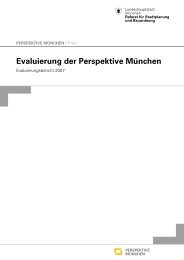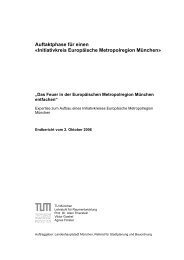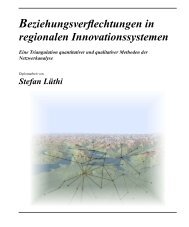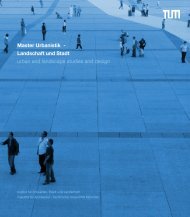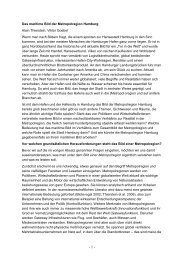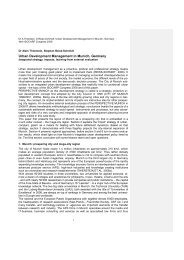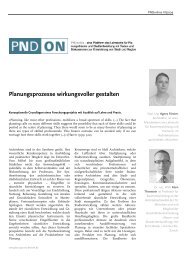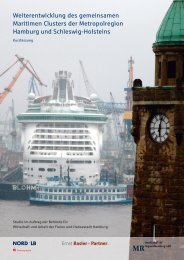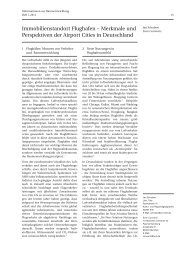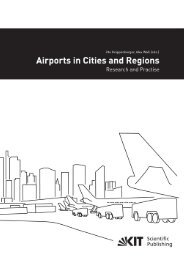0.6-1-Cover and Table of Contents-pp 0-05.indd - Raumentwicklung ...
0.6-1-Cover and Table of Contents-pp 0-05.indd - Raumentwicklung ...
0.6-1-Cover and Table of Contents-pp 0-05.indd - Raumentwicklung ...
You also want an ePaper? Increase the reach of your titles
YUMPU automatically turns print PDFs into web optimized ePapers that Google loves.
The Role <strong>of</strong> the Design Studio in Shaping an Architectural Education for Sustainable Development:<br />
The Case <strong>of</strong> Beirut Arab University<br />
KHALID S. AL-HAGLA<br />
in these courses - to develop an underst<strong>and</strong>ing<br />
<strong>of</strong> the building elements, which pertain to the<br />
modification <strong>of</strong> the microclimate for purposes<br />
<strong>of</strong> human use <strong>and</strong> comfort (NCARB, 2000).<br />
This a<strong>pp</strong>roach makes minor intervention to the<br />
curriculum as the overall curriculum remains<br />
largely unchanged <strong>and</strong> the importance <strong>of</strong><br />
the ECS subjects <strong>and</strong> environmental topics in<br />
related courses are increased. In addition the<br />
curriculum has to be adapted to contain more<br />
in depth courses in environmental controls<br />
(Fraker, 2000).<br />
While having an advantage that the faculty<br />
who has an underst<strong>and</strong>ing <strong>of</strong> the technical<br />
aspects <strong>of</strong> the subject material is central to the<br />
introduction <strong>of</strong> sustainability into other areas<br />
<strong>of</strong> the program, this a<strong>pp</strong>roach is criticized for<br />
a number <strong>of</strong> defects. The first is the shrinkage<br />
in the importance <strong>of</strong> a number <strong>of</strong> courses<br />
including the design studio compared with<br />
the growing importance <strong>of</strong> ECS subjects.<br />
The second is narrowing the responsibility <strong>of</strong><br />
conducting the sustainability underst<strong>and</strong>ings to<br />
a very few faculty that may not be in a position<br />
to fully integrate the subject into the design<br />
studio ‘they are not the individuals guiding the<br />
design theory in the program’ (Wright, 2003)<br />
put a limitation to this a<strong>pp</strong>roach. However,<br />
this a<strong>pp</strong>roach needs to highlight the technical<br />
aspects <strong>of</strong> sustainable design with the possibility<br />
<strong>of</strong> understating the need to place the issues<br />
in a larger context within the program (Wright,<br />
2003: 102). The third a<strong>pp</strong>roach draws a wide<br />
range <strong>of</strong> integrating the sustainable design<br />
underst<strong>and</strong>ings into all the course work <strong>and</strong><br />
states it in the curriculum, which needs drastic<br />
changes to curriculum to be reviewed <strong>and</strong><br />
revised to introduce sustainability. One good<br />
example <strong>of</strong> such comprehensive a<strong>pp</strong>roach is<br />
the center for Regenerative Studies at Cal Poly<br />
Pomona where it <strong>of</strong>fers a physical community<br />
where students from different majors live,<br />
study, <strong>and</strong> work together in a permaculture<br />
setting (Fleming, 2002: 147). This a<strong>pp</strong>roach is<br />
characterized by including the entire faculty<br />
in the subject <strong>of</strong> sustainability <strong>and</strong> ensures the<br />
integration <strong>of</strong> the subject into all the course<br />
work, including the design studio (Wright, 2003:<br />
103). The difficulties <strong>of</strong> this a<strong>pp</strong>roach are that<br />
it needs a commitment <strong>of</strong> the entire faculty<br />
to the exploration <strong>of</strong> the subject <strong>and</strong> requires<br />
a complete revision <strong>of</strong> the curriculum, which is<br />
practically not easy to achieve.<br />
The actual challenge at the pedagogical<br />
level is how to develop design projects to<br />
promote an interdisciplinary setting regarding<br />
the traditional cultural misunderst<strong>and</strong>ings<br />
<strong>and</strong> sometimes confrontations. This needs a<br />
comprehensive organization <strong>and</strong> commitments<br />
at different levels (Fleming, 2002: 152). Esmail<br />
Baniassad (2001) asserts that, the challenge is<br />
deep <strong>and</strong> that the change it necessitates will<br />
be fundamental. It is not going to be met by<br />
the addition <strong>of</strong> information on top <strong>of</strong> existing<br />
programs <strong>of</strong> architecture, nor will it be met by<br />
general statements <strong>of</strong> intention. Among these<br />
operational challenges, a number <strong>of</strong> obstacles<br />
st<strong>and</strong> against achieving more advances. On<br />
the one h<strong>and</strong>, many architectural faculties do<br />
not care enough about the issues or cannot<br />
find ways to integrate a new pedagogical<br />
focus into the traditional design studio settings<br />
(Fleming, 2002: 146). On the other h<strong>and</strong>,<br />
shallow interventions in the already existing<br />
curricula by adding more information to<br />
already overburdened studio pedagogy bring<br />
about another obstacle. One more important<br />
obstacle is the long-established thoughts <strong>of</strong><br />
Archnet-IJAR, International Journal <strong>of</strong> Architectural Research - Volume 6 - Issue 1 - March 2012<br />
29



